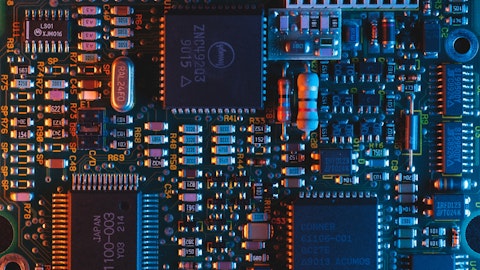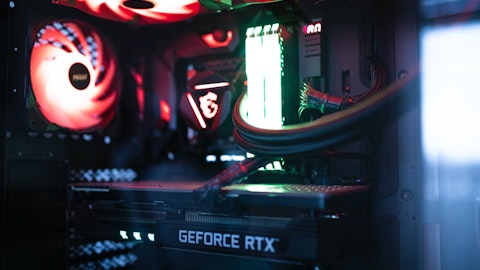Micron Technology, Inc. (NASDAQ:MU) Q3 2023 Earnings Call Transcript June 28, 2023
Micron Technology, Inc. beats earnings expectations. Reported EPS is $2.5, expectations were $-1.56.
Operator: Thank you for standing by, and welcome to Micron’s Third Quarter 2023 Financial Call. At this time, all participants are in a listen-only mode. After the speakers’ presentation, there will be a question-and-answer session. [Operator Instructions] As a reminder, today’s program is being recorded. And now, I’d like to introduce your host for today’s program, Farhan Ahmad, Vice President, Investor Relations. Please go ahead, sir.
Farhan Ahmad: Thank you, and welcome to Micron Technology’s fiscal third quarter 2023 financial conference call. On the call with me today are Sanjay Mehrotra, our President and CEO, and Mark Murphy, our CFO. Today’s call is being webcast from our Investor Relations site at investors.micron.com, including audio and slides. In addition, the press release detailing our quarterly results has been posted on our website, along with the prepared remarks for this call. Today’s discussion of financial results is presented on a non-GAAP financial basis unless otherwise specified. A reconciliation of GAAP to non-GAAP financial measures can be found on our website. We encourage you to visit our website at micron.com throughout the quarter for the most current information on the company, including information on financial conferences that we may be attending.
You can also follow us on Twitter at MicronTech. As a reminder, the matters we are discussing today include forward-looking statements regarding market demand and supply, our expected results, and other matters. These forward-looking statements are subject to risks and uncertainties that may cause actual results to differ materially from statements made today. We refer you to the documents we file with the SEC, including our most recent Form 10-K and 10-Q, for a discussion of risks that may affect our future results. Although we believe that the expectations reflected in the forward-looking statements are reasonable, we cannot guarantee future results, levels of activity, performance, or achievements. We are under no duty to update any of the forward-looking statements to conform these statements to actual results.
I’ll now turn the call over to Sanjay.
Sanjay Mehrotra: Thank you, Farhan. Good afternoon, everyone. Micron delivered fiscal third quarter revenue within our guidance range, with gross margin and EPS above the range. The ongoing improvement of customer inventories and memory content growth are driving higher industry demand, while production cuts across the industry continue to help reduce excess supply. As a result, pricing trends are improving, and we have increased confidence that the industry has passed the bottom for both quarterly revenue and year-on-year revenue growth. Our technology leadership and strengthening product portfolio position us well across diverse growth markets, including AI and memory-centric computing. Beyond this downturn, we expect to see record TAM in calendar 2025 along with a return to more normalized levels of profitability.
The impact of the May 21 decision by the Cyberspace Administration of China on Micron’s business remains uncertain and fluid. Several Micron customers, including mobile OEMs, have been contacted by certain critical information infrastructure operators or representatives of the government in China concerning the future use of Micron products. As discussed before, Micron’s revenue with companies headquartered in mainland China and Hong Kong, including direct sales as well as indirect sales through distributors, accounts for approximately a quarter of Micron’s worldwide revenue and remains the principal exposure. We currently estimate that approximately half of that China-headquartered customer revenue, which equates to a low double-digit percentage of Micron’s worldwide revenue, is at risk of being impacted.
This significant headwind is impacting our outlook and slowing our recovery. Micron is working to mitigate this impact over time and expects increased quarter-to-quarter revenue variability. Micron’s long-term goal is to retain its worldwide DRAM and NAND share. Turning to technology. Micron continues to lead the industry in both DRAM and NAND technology. We are investing prudently to maintain our technology competitiveness while managing CapEx, node ramps and wafer start reductions to reduce our bit supply and align it with demand. Our industry-leading 1-beta DRAM and 232-layer NAND nodes are achieving world-class yields, and the yield ramp for these nodes has been faster than any of our prior nodes. These leadership nodes provide a strong cost capability, along with best-in-class power and performance specifications that will be leveraged across the portfolio of DRAM and NAND products.
In fiscal Q3, we achieved several important product qualifications on these advanced nodes and are well positioned to ramp them in fiscal 2024. We are also making good progress toward the introduction of our EUV-based 1-gamma node in 2025. This node will be manufactured first in our Taiwan site, where we already have EUV capability installed and operating in preparation for this ramp. We also recently announced plans to bring EUV technology to our fab in Hiroshima, Japan, with support from the Japanese government. Micron will be the first company to bring EUV technology to Japan for production. We are also advancing our global assembly and test network in order to support our product portfolio and extend our ability to deliver on global customer demand in the future.
In China, we announced an investment of approximately $600 million over the next several years in our operations in Xi’an. This builds on our long history of significant investment in our Xi’an assembly, packaging and test operations. As a part of this investment, we have decided to purchase the assembly equipment of our partner Powertech Semiconductor Xi’an, who has been operating inside our Xi’an facility for the last eight years. We also intend to construct a new building at our Xi’an site to provide space to add more product capabilities. This will allow us, over time, to serve more of the demand from our customers in China from the Xi’an site. In India, with the strong support of the Indian government, we will build a new assembly and test facility in Gujarat to address demand for the latter half of this decade.
We are also increasing our investments in assembly and test capacity in Taiwan for high-bandwidth memory products as we gear up for stronger demand in this segment driven by the AI wave. Now turning to our end markets. Customers continued to make progress in reducing their excess inventory in fiscal Q3. Most customer inventories in the PC and smartphone segments are close to normal levels now, consistent with our forecast six months ago. Some of these inventory levels can get distorted by customer attempts to leverage current prices, which are deemed to be transient and unsustainable at these levels, to purchase additional volumes before prices rise significantly. Data center customer inventory is also improving and will likely normalize around the end of this calendar year or somewhat thereafter, depending on the growth in traditional data center spending.
In data center, we saw strong sequential revenue growth in both cloud and enterprise in fiscal Q3, driven by some recovery from depressed sales levels in fiscal Q2. The recent acceleration in the adoption of generative AI is driving higher-than-expected industry demand for memory and storage for AI servers, while traditional server demand for mainstream data center applications continues to be lackluster. Micron’s product portfolio and roadmap of innovative products position us to capture growth opportunities from AI and data-centric computing architectures for both training and inferencing. Increasingly large AI models with an exponentially growing number of parameters are driving demand for dramatically higher memory content. As we have said before, AI servers have six to eight times the DRAM content of a regular server and three times the NAND content.
In fact, some customers are deploying AI compute capability with substantially higher memory content. A striking example is NVIDIA’s DGX GH200 supercluster, which shows just how memory-intensive AI workloads can be; it provides developers the ability to support giant models with a massive, shared memory space of 144TB. A significant majority of that memory footprint is enabled by a joint development project between our two companies that extends Micron’s low-power DRAM leadership to server class applications. We are proud to pioneer this differentiated LP DRAM innovation to deliver a significant reduction in data center power consumption compared to DDR-based solutions, helping to support our customers’ green initiatives. High-bandwidth memory, used in high performance computing, is seeing very strong demand this year, driven by demand for generative AI.

Photo by christina wocintechchat on Unsplash
We are working closely with our customers and have begun sampling our industry-leading HBM3 product offering. The customer response has been strong, and we believe our HBM3 product delivers significantly higher bandwidth than competing solutions and establishes the new benchmark in performance and power consumption, supported by our 1-beta technology, TSV, and other innovations enabling a differentiated advanced packaging solution. We expect to begin a mass production ramp for this exciting HBM3 product in early calendar 2024 and to achieve meaningful revenues in fiscal 2024. Micron also has a strong position in the industry transition to D5, which is the latest generation of DDR memory. Our D5 percentage of DRAM shipments has more than doubled from fiscal Q2 to Q3, and we expect Micron D5 volume to cross over D4 at the end of first calendar quarter of 2024 versus mid-calendar 2024 for the industry.
Micron’s 1-alpha D5 modules are qualified and shipping to data center customers. We are also making good progress on our 1-beta-based, high-density 128 gigabyte D5 modules using a 32 gigabit die that optimizes cost and performance to provide customers with a lower cost-of-ownership solution for memory-intensive workloads like AI. We expect these high-density modules to ramp in calendar Q2 of 2024 with significant cost improvements over today’s expensive TSV-based solutions in the industry. Our 96 gigabyte D5 high-density module built on 1-alpha technology, using 24 gigabit die, is already shipping in volume and delivers equivalent performance for the majority of workloads versus the more expensive TSV dual-die package-based 128 gigabyte modules.
In data center SSDs, Micron’s entire portfolio is now on 176-layer or 232-layer NAND, demonstrating our product and technology leadership. We are in a strong position to serve AI demand for fast storage as these data-intensive applications proliferate. In fiscal Q3, we launched the world’s first 200-plus layer NAND data center SSD, and qualification is in progress at multiple key customers to support AI cluster installations. In fact, we have already passed qualification of this product at a critical server OEM partner. We also launched our extreme endurance data center SSD, which offers superior scalability and affordability versus hard drives. In PCs, we now forecast calendar 2023 PC unit volume to decline by a low double-digit percentage year-over-year, with PC units expected to be below the pre-COVID levels last seen in 2019.
We are excited about the ongoing industry transition to D5 and are well positioned for it with our strong D5 product lineup. Industry client D5 mix is expected to cross over from D4 in early calendar 2024. In fiscal Q3, we achieved record quarterly client SSD bit shipments, driven by share growth in client SSDs as customers adopted our industry-leading solutions. Our SSD QLC bit shipment mix reached a new record for the third consecutive quarter, with growth in both client and consumer. Last month, we launched Crucial T700, the world’s fastest Gen5 PCIe consumer SSD, built with our 232-layer NAND. In graphics, industry analysts continue to expect graphics’ TAM growth CAGR to outpace the broader market, supported by applications across client and data center.
We expect customer inventories to normalize in calendar Q3. We plan to introduce our next-generation G7 product on our industry-leading 1-beta node in the first half of calendar year 2024. In mobile, we now expect calendar 2023 smartphone unit volume to be down by a mid-single digit percentage year-over-year. While units are weaker, we are seeing stronger memory content growth driven by a mix shift toward premium phones and elasticity. We expect sequential growth in fiscal Q4 as customers prepare for upcoming product launches in the back half of calendar 2023. In fiscal Q3, we achieved key mobile customer qualifications on our 1-beta-based LP5X and started high-volume revenue shipments to Tier-1 OEMs. In addition, we achieved significant milestones in UFS with the qualification and ramp of a high-capacity uMCP5 featuring 16 gigabyte of DRAM and 512 gigabyte of NAND.
We have also started to sample a new UFS 4 product based on our latest 232-layer NAND technology, which enables industry-leading performance for flagship handsets. Last, I’ll cover the auto and industrial end markets, which represent over 20% of our revenue and contribute more stable revenue and profitability. Micron continues to lead in automotive, which is a key market and growth driver for us. In fiscal Q3, auto revenue reached another quarterly record and grew by a high single-digit percentage year-over-year. We continue to expect growth in auto memory demand for the second half of calendar 2023, driven by easing non-memory semiconductor supply, normalizing customer inventory levels, and increasing memory content per vehicle. The industrial market saw early signs of recovery in fiscal Q3.
Inventory levels are stabilizing at distribution partners and at the majority of our customers. As a result, we expect an improvement in demand in the second half of calendar 2023. We are excited about our growth prospects in this market, as industrial customers continue to adopt and implement IoT, AI, and machine learning in the factory. Now, turning to industry outlook. Our expectations for calendar 2023 industry bit demand growth have been further reduced to low- to mid-single digits in DRAM and to high-single digits in NAND, which are well below the expected long-term CAGR of mid-teens percentage range in DRAM and low 20%s range in NAND. While the AI-driven demand has been stronger than our expectations three months ago, the PC, smartphone and traditional server demand forecasts are now lower.
We continue to expect stronger industry bit shipments for DRAM and NAND in the second half of the calendar year, driven by secular content growth and continued improvement in customer inventory. While the industry demand forecast for calendar 2023 is now lower, the significant supply reductions across the industry have started to stabilize the market. We see both DRAM and NAND year-over-year supply growth to be negative for the industry in calendar 2023 as utilization and CapEx cuts across the industry impact supply growth. While supply demand balance is improving, due to the excess inventory, profitability and cash flow will remain extremely challenged for some time. Market recovery can accelerate if there is further reduction in industry production and these cuts are sustained well into calendar 2024.
In response to the industry environment, Micron has taken decisive actions to bring our supply back in balance with demand. We expect Micron’s year-on-year bit supply growth to be meaningfully negative for DRAM. We also expect to produce fewer NAND bits in calendar 2023 than in calendar 2022. Our fiscal 2023 CapEx plan of $7 billion is down more than 40% from last year, with WFE down more than 50%. We continue to expect fiscal 2024 WFE to be down year-on-year. Recently, we have further reduced wafer starts to approach 30% in both DRAM and NAND. We currently expect reduced wafer starts will continue well into calendar 2024 as we remain focused on managing down our inventories and controlling our supply. I will now turn it over to Mark.
Mark Murphy: Thanks, Sanjay. Good afternoon, everyone. Fiscal Q3 results were in line to better than expectations, with revenue coming in above the midpoint of our guidance range and gross margin and EPS exceeding the high end of the range. Total fiscal Q3 revenue was approximately $3.8 billion, up 2% sequentially and down 57% year-over-year. Fiscal Q3 revenue included $72 million from an insurance settlement disclosed at the time we provided guidance. Fiscal Q3 DRAM revenue was $2.7 billion, representing 71% of total revenue. DRAM revenue declined 2% sequentially, with bit shipments increasing in the 10% range and prices declining by approximately 10%. Fiscal Q3 NAND revenue was $1 billion, representing 27% of Micron’s total revenue.
NAND revenue increased 14% sequentially, with bit shipments increasing in the upper 30% range and prices declining in the mid-teens percentage range. Now turning to revenue by business unit. Compute and Networking Business Unit revenue was $1.4 billion, up 1% sequentially. Strong sequential growth in server and graphics revenues was offset by a decline in client. Embedded Business Unit revenue was $912 million, up 5% sequentially. On a sequential basis, automotive and consumer revenues were strong. Revenue for the Mobile Business Unit was $819 million, down 13% sequentially due to timing of shipments. As Sanjay mentioned, we expect growth in mobile revenues in fiscal Q4. Revenue for the Storage Business Unit was $627 million, up 24% sequentially and driven by increased shipments across most of the portfolio.
The consolidated gross margin for fiscal Q3 was negative 16%, improving 15 percentage points sequentially. This result was negatively impacted by approximately $400 million or 11 percentage points of write-downs associated with inventory produced in the quarter. Operating expenses in fiscal Q3 were $866 million, down roughly $50 million sequentially. OpEx benefited from ongoing expense-reduction initiatives and gains on sales of certain assets. We had an operating loss of roughly $1.5 billion in fiscal Q3, resulting in an operating margin of negative 39%, improved from negative 56% in the prior quarter. Fiscal Q3 taxes were $102 million, higher than expectations at the time of our guidance, driven by one-time discrete items. As mentioned in previous quarters, despite a consolidated loss on a worldwide basis, we still have taxes payable in certain geographies due to taxable income levels reported in those geographies.
The non-GAAP loss per share in fiscal Q3 was $1.43, down from a loss per share of $1.91 in the prior quarter and earnings per share of $2.59 in the prior year. Fiscal Q3 EPS included approximately $0.37 of losses from the impact of the inventory write-down associated with inventory produced in the quarter. Turning to cash flows and capital spending. Our operating cash flows were approximately $24 million. Capital expenditures were $1.4 billion during the quarter. We continue to expect capital expenditures to be approximately $7 billion for the fiscal year, thus near $1 billion in fiscal Q4. Free cash flow was negative $1.4 billion in the quarter and improved from the previous two quarters. Our fiscal Q3 ending inventory was $8.2 billion or 168 days.
Due to increases in process steps and product complexity, we now target inventory levels of around 120 days, which at present would equate to approximately $6 billion. Our current inventories include strategic stocks of approximately $1 billion over target levels associated with build-ahead of product for cost optimization and risk mitigation. At quarter-end, we held cash and investments of $11.4 billion and had total liquidity of $13.9 billion, including our untapped credit facility. We issued $1.5 billion of long-term debt in the quarter and, with part of those proceeds, paid down $600 million of our term loan facility, resulting in a net increase to debt of $900 million. Our fiscal Q3 ending debt was $13.2 billion. Now turning to our outlook for the fiscal fourth quarter.
As mentioned in filings and our comments today, the CAC decision is a headwind to our outlook. We expect the revenue impact to vary by quarter, with the impact in fiscal Q4 being less than the quarterly impact in the first half of fiscal 2024. Over time, we have a goal of retaining our global market share in both DRAM and NAND. In fiscal Q4, as the industry demand continues to improve and despite the effects on our business from the CAC decision, we still see record bit shipments. Fiscal Q4 gross margin will be impacted by costs from underutilization, weak pricing levels and product mix. In the current business environment, the gap between our DRAM and NAND profitability is significant, and changes in the mix can drive large variability in gross margins.
Our gross margin guidance does not contemplate additional write-downs of inventory. We continue to aggressively manage our operating expenses and remain on track to exit the fiscal year at less than $850 million. Looking beyond fiscal Q4, we expect OpEx to increase over $50 million in fiscal Q1 2024 on R&D program expense timing and as reductions to employee compensation end. With all these factors in mind, our non-GAAP guidance for fiscal Q4 is as follows. We expect revenue to be $3.9 billion, plus or minus $200 million; gross margin to be in the range of negative 10.5%, plus or minus 250 basis points; and operating expenses to be approximately $845 million, plus or minus $15 million. We expect tax expenses of approximately $40 million. Based on a share count of approximately 1.1 billion shares, we expect EPS to be a loss of $1.19, plus or minus $0.07.
In closing, we continue to act quickly and tenaciously to navigate this downturn, making the investments to maintain our leading capabilities across technology, products, and manufacturing while preserving our solid balance sheet. In this environment, we remain sharply focused on improving our profitability and free cash flow. As market conditions improve, we will continue to drive efficiencies to hold on productivity gains. Despite the impact of this downturn and effects of the CAC decision, we remain confident in our financial model and our ability to deliver long-term profitability, cash flow and shareholder returns. I will now turn it back over to Sanjay.
Sanjay Mehrotra: Thank you, Mark. I am proud of the execution of the Micron team and the progress we made this quarter. The leadership products we released and qualified are strengthening Micron’s portfolio across multiple key markets. While there are near-term headwinds, I am excited about the new product introductions that we have planned for the next several quarters, which will further enable us to leverage the dramatic growth in AI that is ahead of us. I am confident that this portfolio momentum, combined with our technology capability, manufacturing excellence, financial discipline, and excellent customer relationships, will position us well for the future. I also want to call attention to Micron’s 2023 sustainability report, which published yesterday.
The report underscores our continued commitment to innovation, the environment, our people and the communities where we operate, outlining our progress and aspirations across our environmental, social and governance programs. I encourage you to review the full report on Micron’s website. Thank you for joining us today. We will now open for questions.
See also 35 Safest Countries In the World and 25 Poorest Cities In The US That Are Getting Poorer.
Q&A Session
Follow Micron Technology Inc (NASDAQ:MU)
Follow Micron Technology Inc (NASDAQ:MU)
Operator: Certainly. [Operator Instructions] And our first question comes from the line of C.J. Muse from Evercore ISI. Your question please.
C.J. Muse: Yes, good afternoon. Thank you for taking the question. I guess first question, with inventory expected to normalize in the coming months — quarter, how are you seeing customer purchasing behavior perhaps change given that we’re clearly hitting a pricing trough very soon? We’d love to hear kind of how those discussions might be changing.
Sanjay Mehrotra: Thanks, C.J., for that question. We, of course, continue to work closely with our customers. And as we said that customer inventories are improving. Except for data centers, inventories are close to normal in most of our other end markets. Data center, we said by end of this year or somewhat thereafter — shortly thereafter, data center customer inventories we expect to improve as well. And we continue to work closely with our customers. Some of the customers definitely interested in some of the longer-term outlook for the business and other customers operate on month-to-month basis. And overall, of course, we continue to mitigate through some of the impact of the China decision as well. But the value that we are bringing to the customers for our products continues to strengthen and Micron is very much focused on navigating through the current downturn and working closely with our customers to address their future demand.
And as we said in my remarks that some of the customers, given the low pricing that exists in the industry today, and before prices begin to increase substantially, some of the customers may be looking at purchasing additional volumes at this time. But in general, the trajectory is of continuing improvement in their inventory levels end-to-end across the supply chain, add the customers directly as well as third parties who may be supplying to the customers. And as you know, inventories at the suppliers are coming down as well.
C.J. Muse: Very helpful. If I could just follow-up real quickly on HBM3, you guided to meaningful revs in fiscal ’24. Can you give us a sense of what that means? And over time, what size kind of could that look like for you guys looking at kind of three to five years? Thank you.
Sanjay Mehrotra: Well, with respect to HBM3, we are very excited about this product. Micron has focused on bringing an industry-leading product and HBM3 product that is in early stages of sampling and we expect to begin production volume ramp of this product in early 2024. It is a product that has significantly higher performance, bandwidth and significantly lower power. In fact, as a product, it is close to a generational leap ahead of anything else that is in the market. We have received a strong endorsement for this product in the market and we expect the volume ramp of this product for us to be rapid, to be steep ramp and this will bring in, in our fiscal year 2024, strong revenue growth opportunity for us. So we are very excited about this standout product.
It will be a significant growth driver for Micron. And everything that we have done here is of course built on our industry-leading 1-beta technology and applying to it, of course, advanced packaging, differentiated packaging and TSV capabilities. So this is we believe going to be a standout product for us. And we expect — we target a share with HBM with this kind of industry-leading product that would be higher than our average DRAM share in the industry as well.
Operator: Thank you. One moment for our next question. And our next question comes from the line of Timothy Arcuri from UBS. Your question please.





